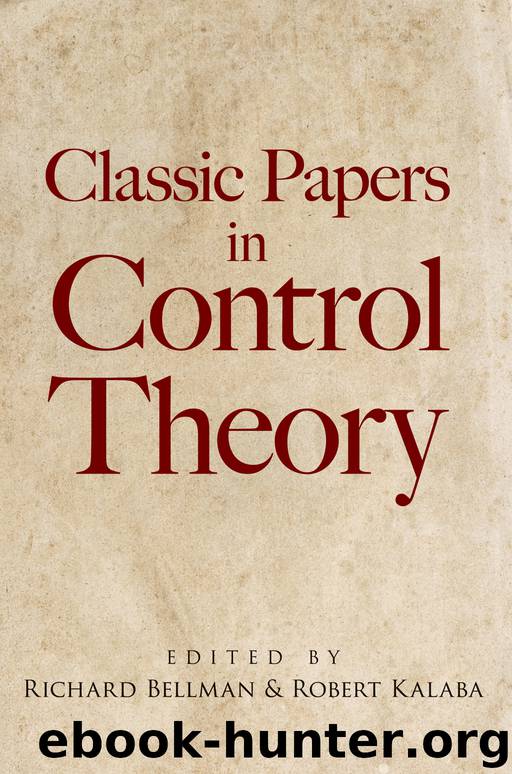Classic Papers in Control Theory by Richard Bellman & Robert Kalaba

Author:Richard Bellman & Robert Kalaba [Bellman, Richard]
Language: eng
Format: epub
Publisher: Dover Publications
Table I: Toll repeater development
The last two columns show what the roadblock was. As we are more ambitious in our uses of carrier and repeater techniques, the total loss in the line and consequently the total number of repeaters must go up. But each repeater is a source of noise and distortion, and the signal degradation produced by all these effects is directly proportional to the total number of repeaters which must be traversed. Most of you with hi-fi systems are no doubt proud of the quality of your audio amplifiers, but I doubt whether many of you would care to listen to the sound after the signal had gone in succession through several dozen or several hundred even of your own fine amplifiers. There is a "tyranny of numbers, " as my reliability friends say, which makes it necessary for the individual components of the system to become qualitatively better as the system as a whole becomes quantitatively more ambitious. The systems envisaged in the third and succeeding lines of Table I simply required too many amplifiers in tandem to yield acceptable over-all quality until a substantial step forward in individual amplifier quality could be made.
The causes of distortion were of various sorts. They included power supply noises, variations in gain, and so on. The dominant problem, however, was the intermodulation due to the slight nonlinearity in the characteristics of the last tube. Various efforts were made to improve this situation, by the selection of tubes, by careful biasing, by the use of matched tubes in push-pull to provide compensating characteristics, and so on. Until Black's invention, however, nothing made a radical improvement in the situation.
Black actually made two inventions. The first1 is now primarily a curiosity, although its principles are still of interest. It is shown in Fig. 1(a), which is intended to be illustrative rather than entirely accurate. The two boxes labeled "+" represent bi-conjugate devices, like three winding transformers or Wheatstone bridges, such that transmission from any input can be obtained to either adjacent output but not to the facing output. The top amplifier is the principal one and transmits through the second bi-conjugate device to the output line. The second amplifier is a compensating device. In operation, the output signal from the principal amplifier is first reduced by the variable attenuator labeled θ and balanced against a sample from the input circuit. If we set θ = 1/μ, so that the loss (and phase) of the variable attenuator exactly equals the gain of the top amplifier, and if the top amplifier is perfect in the sense that its output contains no extraneous noise or modulation components, this balance is precise and nothing is fed to the bottom amplifier. However, extraneous noise or modulation from the top amplifier is not balanced out. Instead, it goes through the bottom amplifier and is combined, with reversed polarity, with the direct feed from the first amplifier, in the second bi-conjugate circuit. Since the gain in the second amplifier is
Download
This site does not store any files on its server. We only index and link to content provided by other sites. Please contact the content providers to delete copyright contents if any and email us, we'll remove relevant links or contents immediately.
| Automotive | Engineering |
| Transportation |
Whiskies Galore by Ian Buxton(41725)
Introduction to Aircraft Design (Cambridge Aerospace Series) by John P. Fielding(33022)
Small Unmanned Fixed-wing Aircraft Design by Andrew J. Keane Andras Sobester James P. Scanlan & András Sóbester & James P. Scanlan(32690)
Craft Beer for the Homebrewer by Michael Agnew(18087)
Turbulence by E. J. Noyes(7901)
The Complete Stick Figure Physics Tutorials by Allen Sarah(7273)
Kaplan MCAT General Chemistry Review by Kaplan(6829)
The Thirst by Nesbo Jo(6769)
Bad Blood by John Carreyrou(6483)
Modelling of Convective Heat and Mass Transfer in Rotating Flows by Igor V. Shevchuk(6359)
Learning SQL by Alan Beaulieu(6166)
Weapons of Math Destruction by Cathy O'Neil(6090)
Man-made Catastrophes and Risk Information Concealment by Dmitry Chernov & Didier Sornette(5883)
Digital Minimalism by Cal Newport;(5593)
Life 3.0: Being Human in the Age of Artificial Intelligence by Tegmark Max(5410)
iGen by Jean M. Twenge(5333)
Secrets of Antigravity Propulsion: Tesla, UFOs, and Classified Aerospace Technology by Ph.D. Paul A. Laviolette(5244)
Design of Trajectory Optimization Approach for Space Maneuver Vehicle Skip Entry Problems by Runqi Chai & Al Savvaris & Antonios Tsourdos & Senchun Chai(4962)
Electronic Devices & Circuits by Jacob Millman & Christos C. Halkias(4871)
